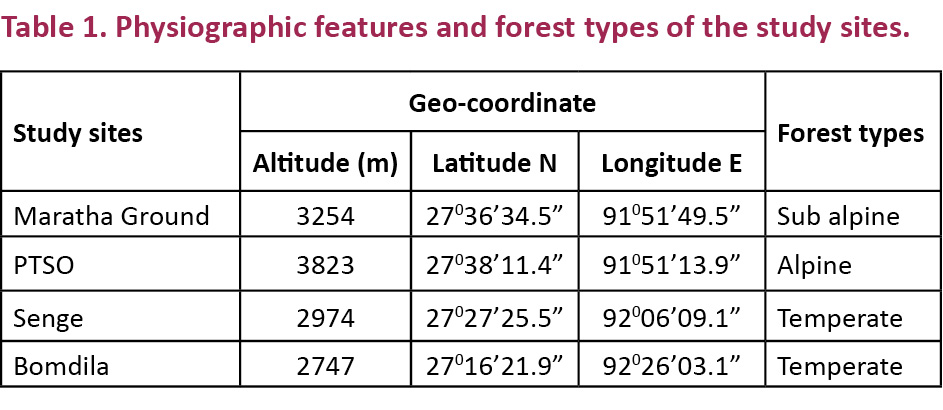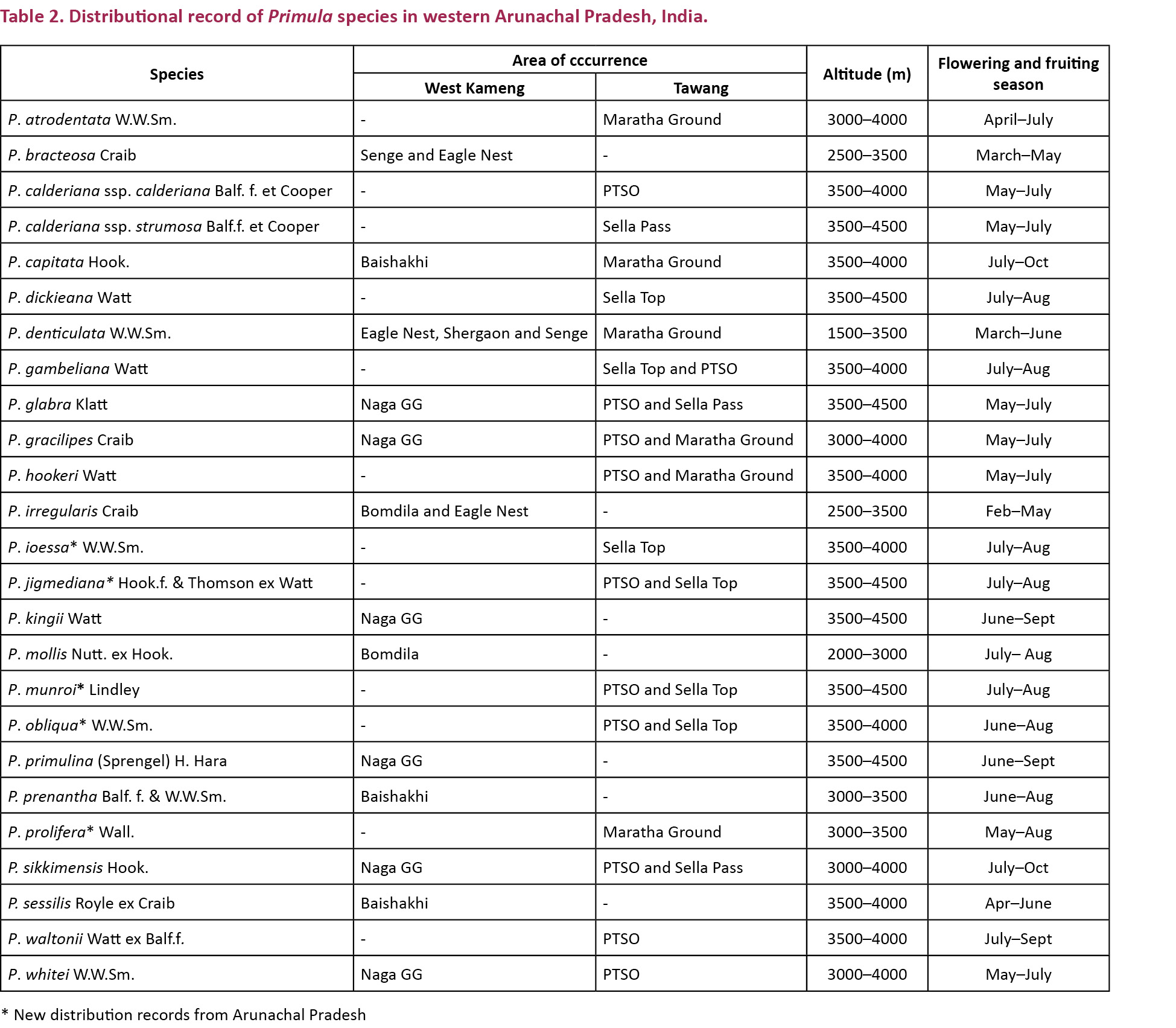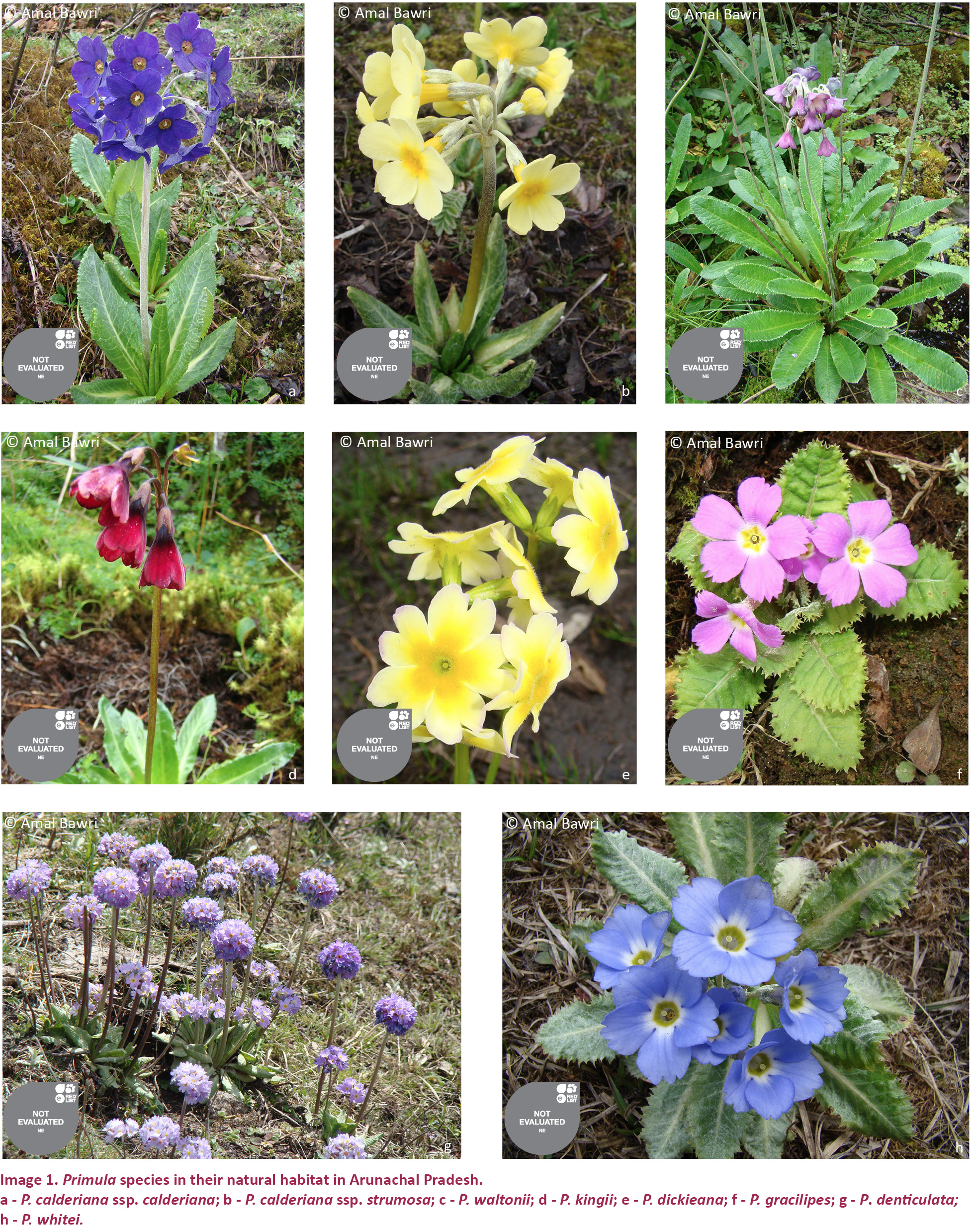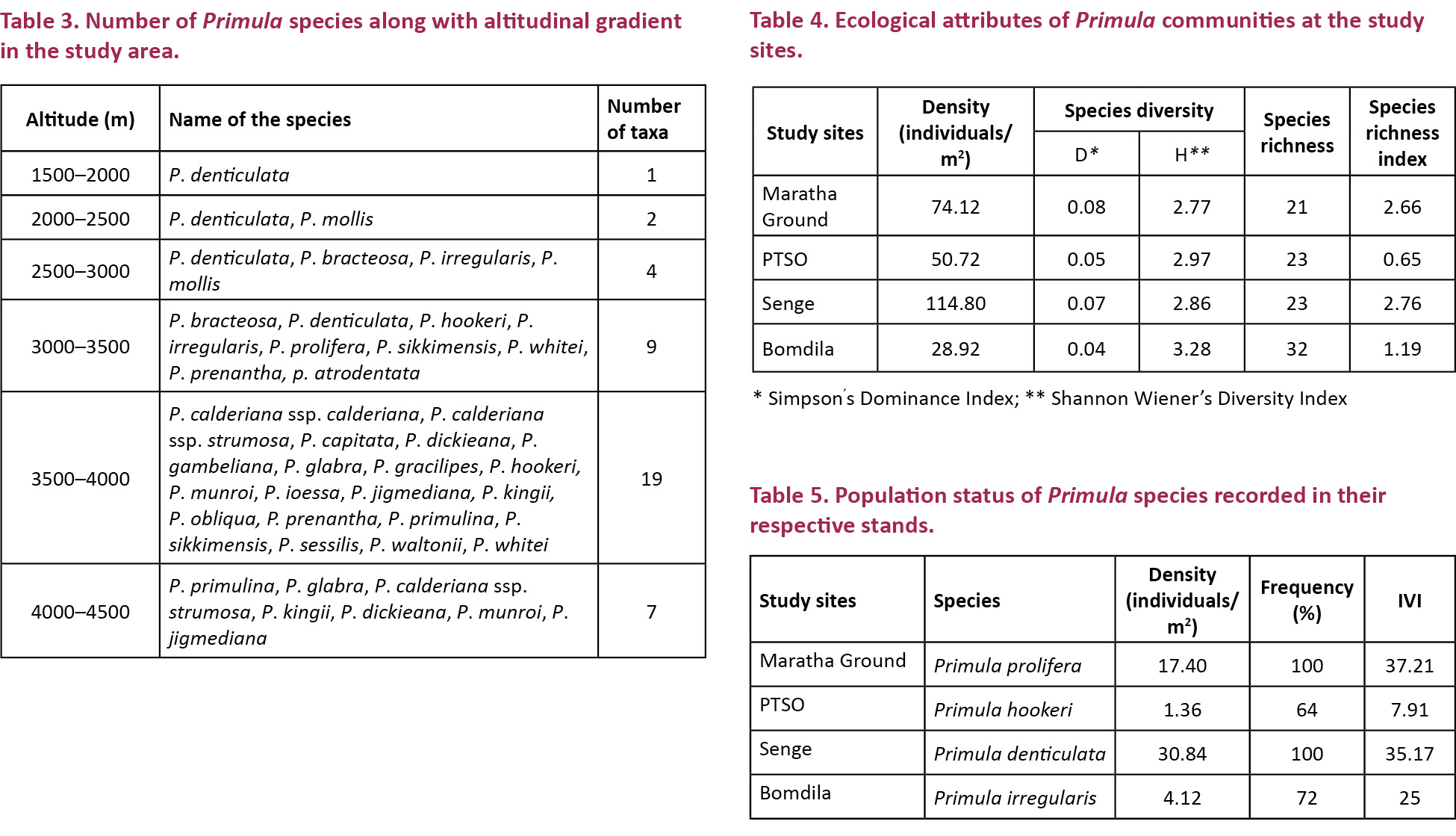Diversity and distribution of Primula species in western Arunachal Pradesh, eastern Himalayan region, India
Amal Bawri 1, Padma Raj Gajurel 2, Ashish Paul 3 & Mohamed Latif Khan 4
1,2 Department of Forestry, North Eastern Regional Institute of Science and Technology (Deemed University), Nirjuli, Arunachal Pradesh 791109, India
3 Department of Botany, Rajiv Gandhi University, Rono Hills, Doimukh, Arunachal Pradesh 791112, India
4 Department of Botany, Dr. Hari Singh Gour Central University, Sagar, Madhya Pradesh 470003, India
1 amalbawri@gmail.com (corresponding author), 2 prgajurel@gmail.com, 3 ashishpaul1@gmail.com, 4 khanml61@gmail.com
Abstract: The paper highlights the diversity, distribution and population status of Primula species in western Arunachal Pradesh. The present study has established the rich diversity of Primula species in western Arunachal Pradesh with a record total of 25 species, out of which five species, viz., Primula ioessa W.W.Sm., Primula munroi Lindley, Primula obliqua W.W.Sm., Primula prolifera Wall. and Primula jigmediana Hook. f. & Thomson ex Watt, are new to Arunachal Pradesh. More than 60% of the taxa of Primula of the state occurs in two districts of the western part of the state. A maximum diversity (76%) of Primula species was recorded between 3500m and 4000m and a minimum (4%) was between 1500m and 2000m. This study showed the poor population of some Primula species in the study area. Among the four sampling sites the Panga-Teng-Tso is highly disturbed which is clearly reflected by very poor population density of P. hookeri (1.36 individuals m-2). Various natural and anthropogenic threats have led to the pressure on the habitat of Primula species. Considering the rich species diversity of Primula and their distributional affinities, western Arunachal Pradesh may be considered as a centre of diversity of Indo-Chinese Primula species and appropriate conservation strategies should be adopted for the conservation of this genus.
Keywords: Arunachal Pradesh, distribution, diversity, population, Primula, threats and conservation.
doi: http://dx.doi.org/10.11609/JoTT.o3721.6788-95
Editor: K.S. Negi, NBPGR-ICAR, Nainital, India Date of publication: 26 January 2015 (online & print)
Manuscript details: Ms # o3721 | Received 24 July 2013 | Final received 10 December 2014 | Finally accepted 19 December 2014
Citation: Bawri, A., P.R. Gajurel, A. Paul & M.L. Khan (2015). Diversity and distribution of Primula species in western Arunachal Pradesh, eastern Himalayan region, India. Journal of Threatened Taxa 7(1): 6788–6795; http://dx.doi.org/10.11609/JoTT.o3721.6788-95
Copyright: © Bawri et al. 2015. Creative Commons Attribution 4.0 International License. JoTT allows unrestricted use of this article in any medium, reproduction and distribution by providing adequate credit to the authors and the source of publication.
Funding: Ashoka Trust for Research in Ecology and the Environment, Eastern Himalayas Office, Darjeeling through John D. and Catherine T. MacArthur Foundation, USA (Sanction No: # ATREE-SGRNE/MAF/01, Dated: 01.10.2010).
Competing Interest: The authors declare no competing interests.
Author Contribution: AB this manuscript is a part of his PhD research work. Field survey, data collection, evaluation, representation and preparation of manuscript. PRG is the supervisor of AB’s PhD and he has executed the field work and preparation of manuscript, guided the work and helped finalization of the manuscript. AP assisted in field survey, analysis of ecological data, representation and preparation of manuscript. MLK is the co-supervisor of AB’s PhD, he helped in technical improvement and finalization of the manuscript. He executed the work on Primula with PRG.
Author Details: Amal Bawri is a PhD scholar, pursuing his Doctoral Research under the Joint Supervision of Dr. P.R. Gajurel and Prof. M.L. Khan on Primula species of Arunachal Pradesh. Dr. Padma Raj Gajurel is an Associate Professor and a field Botanist by profession; did his doctoral research on the experimental taxonomic studies of Piper L. in Arunachal Pradesh. Presently he is engaged in research works on taxonomy of higher plant groups, ethnobotany and conservation biology. Dr. Ashish Paul is a UGC-Dr. D.S. Kothari Post Doctoral Fellow, did his doctoral research on studies on diversity and regeneration ecology of rhododendrons in Arunachal Pradesh. His research focuses on agro-biodiversity, forest ecology, biodiversity conservation, especially in the field of plant diversity, their ecology and management and regeneration ecology. Prof. Mohamed Latif Khan is a professor, his field of research interest is the evaluation on the regeneration status of forest trees, exploration on germplasm of bamboo and cane, conservation of endangered plant species, analysis and monitoring the biodiversity of sacred groves, mapping and quantitative assessment, population status, and geographic distribution of plant resources.
Acknowledgements: Authors are thankful to the Ashoka Trust for Research in Ecology and the Environment (ATREE), Eastern Himalayas Office, Darjeeling and MacArthur Foundation, USA for the financial assistance. Special thanks to Prof. K.S. Bawa for his initiatives and consistent encouragement for this research work. The authors thank local guides and villagers for cooperation during the field study. We deeply acknowledge the help and support of Department of Environment and Forests, Government of Arunachal Pradesh during field survey and collections. Authors are also thankful to the anonymous reviewers for their valuable comments and suggestion.

Introduction
North Eastern Himalayan Region (NEHR) is very rich in biodiversity because of its varied climatic, edaphic conditions and diverse topography. Arunachal Pradesh, as a part of this region and possessing a rich diversity of plant species is truly recognized as one of the 200 globally important ecoregions (Olson & Dinerstein 1998). The flora of Arunachal Himalaya comprises well over 4000 species of flowering plants. The region is also considered as a centre of active speciation for Rhododendron L., Primula L. and Gentiana L. (Takhtadzhinan 1969; Rao 1994). The vegetation of Arunachal Himalaya has been categorised into six broad types, viz.: tropical, subtropical, temperate, sub-alpine, alpine and secondary forests (Kaul & Haridasan 1987). Although the state has a rich diversity of flora and fauna, the state’s biodiversity is yet to be explored and documented scientifically to a great extent.
The genus Primula L. belongs to the Primulaceae family consisting of herbaceous angiosperm plants and distributed in the high altitude areas. This genus is well known for its medicinal and horticultural values (Richards 2003). Many species are cultivated in the gardens for their attractive flowers. Globally, the genus is widely distributed throughout Asia and Europe in the temperate and cold regions and in the tropical mountains of the northern hemisphere (Richards 2003). The genus includes 38 sections and 430 species worldwide. Out of 38 sections, the Sino-Himalayan region represents 26 sections of the genus with more than 300 species (Richards 2003). So the Sino-Himalayan region is regarded as the geographical origin and centre of diversity and distribution of the genus Primula L. (Richards 2003).
The Indian Himalayan region is also considered as one of the centres of the rich species diversity of Primula L. with 106 species distributed from western to eastern Himalaya (Basak et al. 2014). Hooker (1882) reported 43 species of Primula from different parts of the Indian Himalayan region, whereas about 40 species of Primula have been reported only from Arunachal Pradesh (Basak & Maiti 2000; Giri et al. 2008; Boardman et al. 2010). Furthermore, the occurrence of about 50 species from Sikkim Himalaya (Grierson & Long 1999) and 16 species from Himachal Pradesh (Chowdhery 1984) has been reported. The complete Primula diversity of the Himalayan state of Arunachal Pradesh is still unknown, as no extensive study on Primula species has so far been conducted in this area, which is biogeographically linked with China, Bhutan and Myanmar. Therefore, extensive field survey of Primula in the region was carried out to know the diversity, distribution and the status of the species so that conservation and management practices could be initiated.
Materials and Methods
Study area
The study has been carried out in West Kameng and Tawang districts of Western Arunachal Pradesh (Fig. 1). West Kameng District (area 7,422km2) lies between 26054’–28001’N & 91030’–92040’E. The district is bordered by Tibet region in the north, Tawang and East Kameng districts of Arunachal Pradesh are in the north-west and east, respectively. The southern boundary adjoins Sonitpur and Darrang districts of Assam in the south and Bhutan in the west. The district is mostly mountainous. The vegetation types range from tropical to alpine between altitudinal ranges of 500m to 6000m.
Tawang District (area 2,172km2) lies between 27025’–27052’N & 91016’–91059’E. It is surrounded by Tibet in the north, Bhutan in the south-west and Sella ranges separate it from West Kameng District in the east. The vegetation types range from temperate to alpine between altitudinal ranges of 1500m to 6000m.
Four study sites, viz., Panga-Teng-Tso (PTSO), Maratha Ground, Senge and Bomdila, were selected from the study area on the basis of the occurrence of Primula species, for detailed community analysis and population status (Fig. 1). Maratha Ground and PTSO were selected for Primula prolifera Wall. and Primula hookeri Watt from Tawang District while Senge and Bomdila were selected for Primula denticulata W.W.Sm. and Primula irregularis Craib from West Kameng District. The complete physiographic features of the study sites are given in Table 1.


Methods
Extensive field surveys were conducted during the growing season from February 2011 to September 2012 at elevations between 1500m and 4500m in the selected area for the analysis of diversity and distribution of the Primula species. Although Primula is a perennial species, it possesses a dormant stage and is not found round the year. Therefore, the study was conducted only during their growing seasons. The quadrat method was adopted for community analysis. In each site 50 quadrats (1×1 m) were laid randomly. Specimens of various associate plant species were collected and herbarium of each species was prepared following the methods outlined by Jain & Rao (1977) and preserved for identification. The herbarium specimens thus prepared have been deposited in the herbarium of Forestry Department, North Eastern Regional Institute of Science and Technology, Nirjuli. The species were identified with the help of various floras (Hooker 1882; Chowdhery 1984; Richards 2003; Giri et al. 2008) and herbarium specimens at the major Indian herbaria namely ARUN, ASSAM, BSHC, CAL, BSD, and DD. In addition, information regarding geo-coordinates (latitude, longitude and altitude) were recorded with the help of GPS (Garmin). Important community parameters such as frequency and density were calculated following the standard method outlined by Curtis & McIntosh (1950). The species richness index was determined following the methodology outlined by Magurran (1988). The importance value index (IVI) which is defined as the sum of the relative density, relative frequency and relative dominance was calculated following the methods outlined by Curtis (1959). The species diversity index was calculated using the formula given by Shannon & Wiener (1963), while the dominance index was calculated following Simpson (1949).
Results
Diversity and distribution of Primula species
The present study exhibited the occurrence of 25 species in all the study sites (Table 2, Image 1a–h). Among the identified species, five species, viz., Primula prolifera Wall., Primula ioessa W.W.Sm., Primula munroi Lindley, Primula obliqua W.W.Sm. and Primula jigmediana W.W.Sm., are recorded for the first time from Arunachal Pradesh. The detailed distributional records along the altitudinal range reveal that the Primula species confined their distribution between 1500m and 4500m altitude in the study area (Table 3). The highest diversity of Primula species was recorded between 3500m and 4000m with records of a total of 19 species and the lowest (1 species) is found between 1500m and 2000m. Primula denticulata was found to be common and widely distributed between 1500m and 3500m (Table 3).


Community analysis
Species richness
The highest species richness index (2.76) was recorded from Senge study stand, while the lowest (0.65) was recorded in PTSO. In Maratha Ground, it was 2.66, while in Bomdila it was 1.19 (Table 4).

Density
The density of the plant species varied from stand to stand. The highest plant species density (114.80 individuals m-2) was recorded in Senge, while the lowest was exhibited (28.92 individuals m-2) in Bomdila. In Maratha Ground it was (74.12 individuals m-2), while it was (50.72 individuals m-2) in PTSO study stand (Table 4).
Dominance
Dominance was calculated on the basis of the IVI of different herbaceous species and was found to be varying from stand to stand. Primula denticulata, Fragaria vesca, Gnaphalium affine, and Senecio diversifolius were the main dominant plant species in Senge study stand, while Primula irregularis, Fragaria vesca, Plantago erosa, Rubia manjith and Selaginella sp. were the dominant species in the Bomdila study stand. In Maratha Ground, Primula prolifera, Lycopodium sp., Asplenium sp., Senecio diversifolius and Artemisia indica were dominant and Gnaphalium affine, Senecio diversifolius, Rumex nepalensis, Fragaria vesca, Hemiphragma heterophyllum, Artemisia indica were the dominant species in the PTSO study stand. The Simpson dominance index (D) was recorded as 0.08, 0.07, 0.05 and 0.04 in Maratha Ground, Senge, PTSO and Bomdila, respectively (Table 4).
Species diversity
The Shannon-Wiener’s index was the highest (H=3.28) in Bomdila, while it was the lowest (H=2.77) in Maratha Ground. In PTSO and Senge it was 2.86 and 2.97, respectively (Table 4).
Population status of Primula species
The highest population density and IVI of Primula denticulata and Primula prolifera was 30.84 individuals m-2 and 37.21, respectively. And the lowest density and IVI was of Primula hookeri at 1.36 individuals m-2 and 7.91, respectively. The density of Primula prolifera and Primula irregularis were 17.40 and 4.12 individuals m-2, respectively (Table 5).
Threats to Primula
Several anthropogenic and natural threats, viz., grazing, plant harvesting, developmental activities (road and building construction) and landslides have been observed in the study sites. Grazing is found to be the commonest problem prevailing in all the areas. As the genus Primula is a small perennial herb and found in open areas, grazing animals, particularly the Yak, which are heavy animals sometimes destroy the population by stepping on them while browsing grasses. Developmental activities, mostly widening of roads and medicinal plant harvesting activity is the problem next only to grazing affecting the habitat of Primula species.
Discussion
The diversity of Primula species in the temperate and sub alpine forests in western Arunachal Pradesh, India forms an important distribution centre and ecological niche of the taxa in the eastern Himalayan region. Such a rich diversity of Primula species in high altitudes areas in western Arunachal Pradesh may be due to its geographic location adjacent to countries like China and Bhutan with similar climatic as well as edaphic factors (Grierson & Long 1999; Richards 2003). Interestingly all the 24 species recorded and identified in the present study are also found in China except Primula prolifera (Hu & Kelso 1996). It is noteworthy that more than 60% taxa of Primula of the Arunachal Himalaya occur in western Arunachal Pradesh with five new species which are not included in the floristic account by Giri et al. (2008) or any other worker. So, the Indian eastern Himalaya, China and Bhutan form a centre of species diversity and speciation of the genus Primula.
The high altitudes areas of western Arunachal Pradesh in eastern Himalaya harbours a rich plant diversity. The average species diversity index 2.97 recorded from the present study sites is similar to other Himalayan regions such as 1.53–2.88 in the western Himalayas (Samant et al. 1998; Gangwar & Joshi 2006), 2.39–4.63 in the Garhwal Himalayas (Bhandari et al. 1999), 3.10 in the Kashmir Himalaya (Shaheen et al. 2011) and 2.5–3.10 in the trans-Himalayan alpines of Nepal (Panthi et al. 2007). The highest species richness index (2.76) and plant species density (114.80 individuals/m2) was recorded in Senge study stand, as the sites found to be least disturbed where only grazing was observed. The study site PTSO is highly disturbed which is clearly reflected by very poor species richness index (0.65) and the low population density of the Primula hookeri (1.36 individuals m-2). Senecio diversifolia, Gnaphalium affine, Fragaria vesca, etc. are common dominant species in all the study sites. Although it is difficult to compare the result on density due to unavailability of literature, the result on density of Primula species showed poor population. The present recorded density of Primula species concur with the finding of Singh et al. (2008) who also observed nearly a similar result of high altitudes threatened medicinal plant species of Himachal Pradesh, western Himalaya.
It has been observed that both natural and anthropogenic threats have led to the tremendous pressure on the habitat of Primula species in western Arunachal Pradesh. Natural disturbances like landslides and wash out of smaller patches by runoff are frequent, which affects the natural habitat of Primula and along with other plant species and as a consequence of threats, a few of them may become threatened. Grazing is a serious anthropogenic threat throughout the western Arunachal Pradesh as the inhabitants rear Yaks on a large scale, as an important livelihood aspect. These activities may cause a significant decline in populations and species diversity of Primula as the species are herbaceous in nature and a few species are Yak fodder. Hence, many more species are likely to become threatened in the near future. A few species which lack farinose or mealy substances like Primula dickieana, Primula hookeri, Primula kingii and Primula jigmediana are found to be fodder species of Yak, while the other species are also affected during grazing as many of them are either uprooted or trampled upon. The population study in some selected stands clearly indicated that the habitat of both Primula hookeri and Primula irregularis is severely affected by the major identified threats like grazing, plant harvesting, developmental activities, and landslides; a low density of these species was recorded when compared to other species. These species are distributed in some isolated pockets with a few numbers of individuals. The findings of the population density of these two Primula species revealed that they need special attention for conservation. Based on the present field observation and study the species namely Primula hookeri, Primula irregularis, Primula jigmediana, Primula kingii and Primula waltonii may be considered as threatened species of the region.
Conclusion
The conservation of biodiversity remains one of the basic needs in terms of preserving biotic diversity which, in time, translates into a richness of biotic wealth (Paul et al. 2005). The Himalayan alpine region is rich in biodiversity. The rich plant diversity of Indian Himalaya has been utilized by the native people for medicines, food (edible), fuel, fodder, agricultural tools, house construction, small scale enterprise (i.e., baskets, mats, hats making etc.), and in religious ceremonies (Ram 2005). Various anthropogenic activities, illegal exploitation of medicinal and other useful plants are the main threats to the high altitude biodiversity of Arunachal Pradesh. There is a need to control the degradation and disturbance processes deteriorating the community structure and plant biodiversity of the eastern Himalayan temperate and alpine regions. However, this requires a detailed socio-economic study in the area, which is beyond the scope of the present study.
As western Arunachal Pradesh harbours a rich diversity of Primula species, this part of the state should be considered an important landscape for the conservation of the genetic diversity of Indo-Chinese Primula species. Various reports are available on the conservation and research development of Primula species internationally; however, studies on diversity, ecology, taxonomy, breeding methods, conservation and management are yet to be carried out in Arunachal Pradesh. The development and implementation of regional conservation strategies are necessary to protect alpine biodiversity and conservation of the Primula species of the state.
References
Basak, S.K. & G.G. Maiti (2000). Primula arunachalensis sp. nov. (Primulaceae) from the Eastern Himalaya. Acta Phytotaxonomica Geobotany 51(1): 11–15.
Basak, S.K., G.G. Maity & P.K. Hajra (2014). The Genus Primula L. in India: A Taxonomic Revision. Bishen Singh Mohendra Pal Singh, Dehra Dun, India.
Bhandari, B.S., D.C. Nautiyal & R.D. Gaur (1999). Structural attributes and productivity potential of an alpine pasture of Garhwal Himalaya. Journal of the Indian Botanical Society 78(3–4): 321–329.
Boardman, P., A. Chambers, P. Eveleigh & J. Richards (2010). Discovering primulas of subsection Agleniana. Plantsman 9(2): 88–92.
Chowdhery, H.J. (1984). Primulaceae, pp. 443–447. In: Chowdhery, H.J. & B.M. Wadhawa (eds.). Flora of Himachal Pradesh. Vol. 2. Botanical Survey of India, Kolkata, India.
Curtis, J.T. (1959). The Vegetation of Wisconsin: An Ordination of Plant Communities. 1st Edition. University of Wisconsin press, Wisconsin, USA, 657pp.
Curtis, J.T. & R.P. Mclntosh (1950). The interrelations of certain analytic and synthetic phytosociological characters. Ecology 31(3): 434–455; http://dx.doi.org/10.2307/1931497
Gangwar, R.S. & B.D. Joshi (2006). Some medicinal flora in the riparian zone of river Ganga at Saptrishi, Haridwar, Uttaranchal. Himalayan Journal of Environment and Zoology 20(2): 237–241.
Giri, G.S., A. Pramanik & H.J. Chowdhery (2008). Material for the Flora of Arunachal Pradesh. Vol. 2. Botanical Survey of India, Kolkata, India, 103–112pp.
Grierson, A.J.C. & D.G. Long (eds.) (1999). Primulaceae, pp. 516–554. In: Long, D.G. (ed.), Flora of Bhutan: Including A Record of Plants from Sikkim and Darjeeling. Vol. 2. Part II. Royal Botanic Garden, Edinburgh, UK.
Hooker, J.D. (1882). Flora of British India. Vol. 3. Indian Reprint 1983, Bishen Singh Mohendra Pal Singh, Dehra Dun, India, 482–495pp.
Hu, C.M. & S. Kelso (1996). Primulaceae, pp. 99–185. In: Wu, Z.Y. & P.H. Raven (eds.). Flora of China. Vol. 15. Myrsinaceae through Loganiaceae. Science Press (Beijing), China and Missouri Botanic Garden Press (St. Louis), USA.
Jain, S.K. & R.R. Rao (1977). A Hand Book of Field and Herbarium Method. Today and Tomorrow publishers, New Delhi, India, 157pp.
Kaul, R.N. & K. Haridasan (1987). Forest types of Arunachal Pradesh - a preliminary study. Journal of Economic and Taxonomic Botany 9(2): 379–388.
Magurran, A.E. (1988). Ecological Diversity and its Measures. Princeton University Press, New Jersey, USA, 179pp.
Olson, D.M. & E. Dinerstein (1998). The global 200: a representation approach to conserving the earth’s most biologically valuable ecoregions. Conservation Biology 12(3): 502–515; http://dx.doi.org/10.1046/j.1523-1739.1998.012003502.x
Panthi, M.P., R.P. Chaudhary & O.R. Vetaas (2007). Plant species richness and composition in a trans-Himalayan inner valley of Manang District, central Nepal. Himalayan Journal of Sciences 4(6): 57–64.
Paul, A., M.L. Khan, A. Arunachalam & K. Arunachalam (2005). Biodiversity and conservation of rhododendrons in Arunachal Pradesh in the Indo-Burma biodiversity hotspot. Current Science 89(4): 623–634.
Ram, J. (2005). Biodiversity and conservation of high altitude meadows of Uttaranchal Himalaya. Bulletin of the National Institute of Ecology 15: 11–17.
Rao, R.R. (1994). Biodiversity in India: Floristic Aspects. Bisen Singh Mahendra Pal Singh, Dehra Dun, Uttarakhand, India, 316pp.
Richards, J. (2003). Primula. Revised edition. Timber press, London, UK, 346pp.
Samant, S.S., U. Dhar & R.S. Rawal (1998). Biodiversity status of a protected area in West Himalaya: Askot Wildlife Sanctuary. International Journal of Sustainable Development and World Ecology 5(3): 194–203; http://dx.doi.org/10.1080/13504509809469983
Shaheen, H., S.M. Khan, D.M. Harper, Z. Ullah & R.A. Qureshi (2011). Species diversity, community structure, and distribution patterns in Western Himalayan alpine pastures of Kashmir, Pakistan. Mountain Research and Development 31(2): 153–159; http://dx.doi.org/10.1659/MRD-JOURNAL-D-10-00091.1
Shannon, C.E. & W. Weaver (1963). The Mathematical Theory of Communication. University of Illinois Press, Urbana, USA, 144pp.
Simpson, E.H. (1949). Measurement of diversity. Nature 163(4148): 688; http://dx.doi.org/10.1038/163688a0
Singh, K.N., A. Kumar, Gopichand, B. Lal & N.P. Todaria (2008). Species diversity and population status of threatened plants in different landscape elements of the Rohtang pass, western Himalaya. Journal of Mountain Science 5(1): 73–83; http://dx.doi.org/10.1007/s11629-008-0073-4
Takhtadzhinan, A.L. (1969). Flowering Plants: Origin and Dispersal. 1st Edition. Oliver and Boyd, Edinburgh, UK, 320pp.